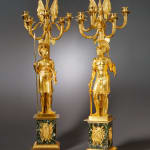
Hans Ottomeyer and Peter Pröschel, “Vergoldete Bronzen”, 1986, p. 396, pls. 5.18.8 and 5.18.9, illustrating two comparable pairs of slightly later candelabra in the Royal Palace Stockholm supplied respectively in 1821 and 1820 to the Swedish crown by Gérard Jean Galle, the first portraying Mars and Minerva and the other Odysseus and Telemach with the latter, as here, having a central upright candle branch adorned with a pair of standards, above a ring of scrolled candle branches. And p. 397, pl. 5.18.12, illustrating a clock with Minerva of circa 1820 by Gérard-Jean Galle in the Royal Palace Stockholm.

Jean-Pierre Samoyault, “Pendules et Bronze d’Ameublement entrés sous le Premier Empire”, 1989, p. 160, no. 138, illustrating a pair of gilt bronze and dark green marble candelabra by Claude Galle with armorial motifs but no figures, which were supplied to Napoleon Bonaparte for the Palais de Fontainebleau.
Claude Galle (attributed to)
Further images
Literature
Hans Ottomeyer and Peter Pröschel, “Vergoldete Bronzen”, 1986, p. 396, pls. 5.18.8 and 5.18.9, illustrating two comparable pairs of slightly later candelabra in the Royal Palace Stockholm supplied respectively in 1821 and 1820 to the Swedish crown by Gérard Jean Galle, the first portraying Mars and Minerva and the other Odysseus and Telemach with the latter, as here, having a central upright candle branch adorned with a pair of standards, above a ring of scrolled candle branches. And p. 397, pl. 5.18.12, illustrating a clock with Minerva of circa 1820 by Gérard-Jean Galle in the Royal Palace Stockholm.
Jean-Pierre Samoyault, “Pendules et Bronze d’Ameublement entrés sous le Premier Empire”, 1989, p. 160, no. 138, illustrating a pair of gilt bronze and dark green marble candelabra by Claude Galle with armorial motifs but no figures, which were supplied to Napoleon Bonaparte for the Palais de Fontainebleau.
An impressive and fine quality, one showing Mars the mythological god of war and the other showing Minerva the mythological warrior goddess, both surmounted by a central upright trumpet-shaped candle holder adorned with a pair of crossed ribbon-tied standards and surrounded below by five scrolled candle branches cast with oak leaves and rosettes, issuing from a pair of foliate rings with each terminating in a vase-shaped drip-pan and circular nozzle above a fluted shaft flanked by a pair of large upright axes. The candelabrum with Minerva, standing facing to her left in front of the fluted shaft, wearing a plumed helmet and breastplate cast with the serpent haired head of Medusa above a sash, a short tunic beneath it and caligae on her feet, holding a spear in her right hand and a sprig of laurel in her left. The candelabrum with Mars standing facing to his right in front of the shaft, wearing a plumed helmet and breastplate above a pterugres (a skirt of leather or fabric lappets) and caligae on his feet, holding a sword in his right hand and an angular shield in his left. Both on squared plinths upon a rectangular-shaped vert-maurin pedestal decorated on the front with an amorial gilt bronze trophy comprising an oval shield headed by a plumed helmet and crossed behind by a quiver of arrows, an axe, a pair of spears, a sword and standard, the sides of the pedestal decorated with mounts comprising a ribbon-tied laurel wreath enclosing the eagle of victory, each upon a stepped stiff leaf border above a square base
Paris, date circa 1815
Height 95 cm. each.
While the specific identity of the maker of these magnificent candelabra is unrecorded, they were almost certainly made in the Galle workshop, firstly run by the eminent fondeur-ciseleur Claude Galle (1759-1815) and then after his death by his son and sucessor Gérard-Jean Galle (1788-1846). In addition to slightly later candelabra supplied by Gérard-Jean Galle were comparable examples with armorial motifs made by Pierre-Philippe Thomire (1751-1843), Claude-François Rabiat (1756-1815) and André-Antoine Ravrio (1759-1814), who like Galle were furnishers of the finest bronzes during Napoleon’s reign.
Either these of very similar candelabra were sold by Sotheby’s Monaco on 21st February 1988, lot 714. As noted above, similar but later pairs were supplied by Gérard-Jean Galle in 1821 to the Royal Palace in Stockholm, in addition to others at Pavlovsk Palace, supplied by him to the Russian Imperial family (illustrated in Alexeieva V. Alexeieva, “Pavlovsk, The Collections”, 1993, p. 191, pls. 37 and 39). Comparable but slightly later candelabra with Mars simply holding a sword and Minerva a shield, on gilt bronze rather than marble plinths attributed to Gérard-Jean Galle were sold at Sotheby’s London, 12th May 2015, lot 79 and also from the collection of Ariane Dandois at Sotheby’s New York, 25th October 2007, lot 1, while a pair depicting Minerva holding a sword and Mars holding a shield were sold at Sotheby’s, Zurich, 10th December 1996, lot 460.
With their detailed casting and chasing glorifying the virtues of war, these candelabra typify the spirit of the Empire period. The figures of Mars and Minerva not only symbolise the embodiment of war but were also considered by the ancients as bearers of of light. Thus they were more than appropriate figures to appear on candelabra since they reflected the Apollonian theme of light winning over darkness. According to mythology, Mars and Minerva were two of the twelve Olympians deities. Minerva was worshipped both as a goddess of wisdom as well as a goddess of war and protected many Greek cities, notably Athens, hence her Greek name Pallas Athena or Athene. According to mythology she was the daughter of Jupiter and sprang fully armed from his head. She was a virgin goddess who refused to marry and as a warrior-goddess, participated in the god’s battle against the giants. Due to her conquests she is often associated with victory, hence here she holds a laurel wreath (symbol of victory) and, as often portrayed, she wears a helmet and holds a spear. The serpent-haired head of Medusa was given to her by Perseus after she had helped him slay the monster; hence Medusa’s head appears here on her breastplate. The figure of Minerva also featured as a clock case produced by Gérard-Jean Galle, of which examples can be found in Schloss Ehrenburg at Coburg, the Ministry of Foreign Affairs, Paris and the Spanish Royal Collection (illustrated in Luis Montañés, “Catálogo ilustrado del Museo de Relojes de las bodegas Zoilo Ruiz-Mateos”, 1977, p. 138). According the mythology, Mars was also the son of Jupiter by Juno but in contrast to Minerva, who defended the arts and represented the positive aspects of war, he was very often violent, never laying down his arms except when in love - with his most famous affair being that with Venus, the goddess of love.
Although similar candelabra were supplied by Gérard-Jean Galle, the model for these candelabra may well have been produced earlier when his father Claude Galle ran this famous firm, especially since the overall design and individual elements such as the oak leaves on the candle branches, the laurel wreaths and marble plinth, belong more succinctly to the earlier Empire period. For instance one can compare them to a pair of gilt bronze candelabra with armorial motifs but no figures, scrolled branches cast as here with oak leaves and having a green marble plinth and base, which Claude Galle supplied in 1807 to the Emperor for his residence at the Palais de Fontainebleau (illustrated in Samoyault, op. cit. p. 160, no. 138).
The Galle dynasty began with Claude Galle who was one of the finest gilders and bronze makers of his day and as such enjoyed the patronage of royalty, the aristocracy and Napoleon Bonaparte. Born at Villepreux near Versailles he was apprenticed in Paris under the fondeur, Pierre Foy. In 1784 he married Foy’s daughter and on his father-in-law’s death in 1788 took over his workshop, which he built up into one the finest of its kind. He then moved the business to Quai de la Monnaie and from 1805 operated from 60 rue Vivienne. First listed in the trade registers in 1784 he was received as a maitre-fondeur in 1786 and promptly gained the first of many commissions from the Garde-Meuble de la Couronne. He is known to have collaborated with Pierre-Philippe Thomire, amongst others, and was responsible for the majority of bronzes d’ameublement supplied during the Empire to Château de Fontainebleau as well as Saint-Cloud, the Trianons, Tuileries, Compiègne, Rambouillet and a number of the Italian palaces including Monte Cavallo, Rome and Stupinigi near Turin. Today his work can be found among the world’s finest collections which in addition to the above Imperial palaces include the Musée National de Château de Malmaison, the Musée Marmottan in Paris, the Museo de Reloges at Jerez de la Frontera, the Residenz Munich and the Victoria and Albert Museum in London.
After his death Galle’s business was reopened and prospered under his son, Gérard-Jean Galle who took over the family business at rue Vivienne and soon proved that he could maintain its excellent repute. Regarded as one of the best in Paris, he was patronised by an elite clientele including the duc de Richelieu, the marquis de Martel and viscount de la Rochefoucauld. Born at rue du Four, Paris, Gérard-Jean and his younger brother, Jean-Auguste (b. 1790) trained under their father but to the latter’s disappointment both joined the army once their apprenticeship was complete. Gérard-Jean proved a brilliant soldier and was knighted in 1815. Five years earlier Claude Galle remarried. In the same year he wrote to the Emperor requesting his sons’ leave from the army so that they could run the family business; this however did not happen for another five years. In 1815 Napoleon was finally overthrown and Claude Galle died, leaving Gérard-Jean’s stepmother in temporary charge. It was then that the newly returned Gérard-Jean took over the Galle workshop.
Gérard-Jean Galle soon created an outstanding collection of bronzes including candelabra, assorted lumières and figural clockcases as well as centrepieces, vases and freestanding figures. Some of these were shown by him at the Exposition de 1’Industrie, Paris in 1819, for which he was awarded a silver medal. Galle supplied some of the best Parisian clockmakers including Jean-Simon Bourdier (d. 1839). He also specialized in making clocks with corresponding candelabra, of which two pairs, cited above, are at the Royal Palace Stockholm. Despite his high repute, Galle suffered significant financial difficulties – a fate that was experienced by many who made luxury items during that period, when political upheaval meant that money was often in short supply. In 1822, he moved the business from rue de Vivienne to rue de Richelieu where he continued as manager until 1836. Two years later the company was bought by the House of Serrurot, makers of wall clocks, torchères and girandoles. Gérard then went into semi-retirement accepting a position with the Royal department of Conservation and later as a Crown inspector.





